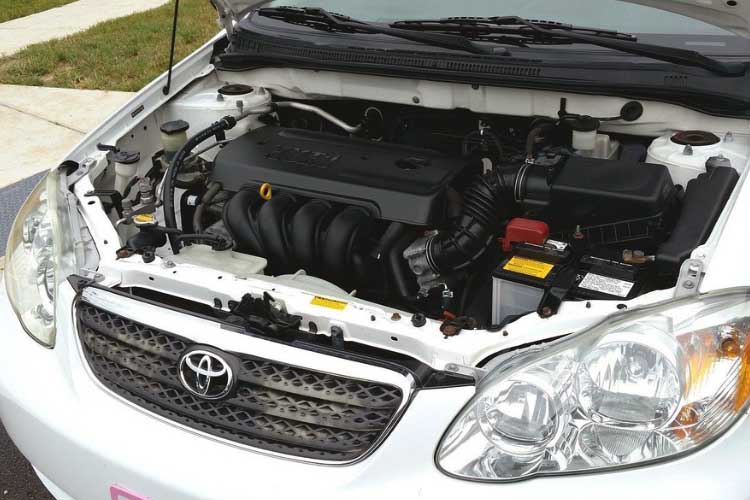Car Overheating But No Leaks (Possible Causes & Solutions)
Engine overheating is usually the result of a coolant leak. But in some cases, your engine may overheat but not show any evidence of the coolant leaking where you’ve parked your car. And this brings forth the question, why is your car overheating but no leaks?
Car overheats but no leaks have many possible culprits which include a clogged radiator, a faulty thermostat, air trapped in the cooling system inhibiting coolant flow, a bad water pump, malfunctioning cooling fans, plugged hoses, or a broken serpentine belt. A failing head gasket could also be the cause of this issue.
Read the following guide for more helpful information on why your engine is overheating without showing any signs of a leak. Plus, we’ve discussed tips on how to diagnose leaks and resolve the overheating problem before it damages your engine.
Why is your car overheating but no leaks?
If your car is overheating but no visible leak underneath your car, that doesn’t mean your engine isn’t leaking.
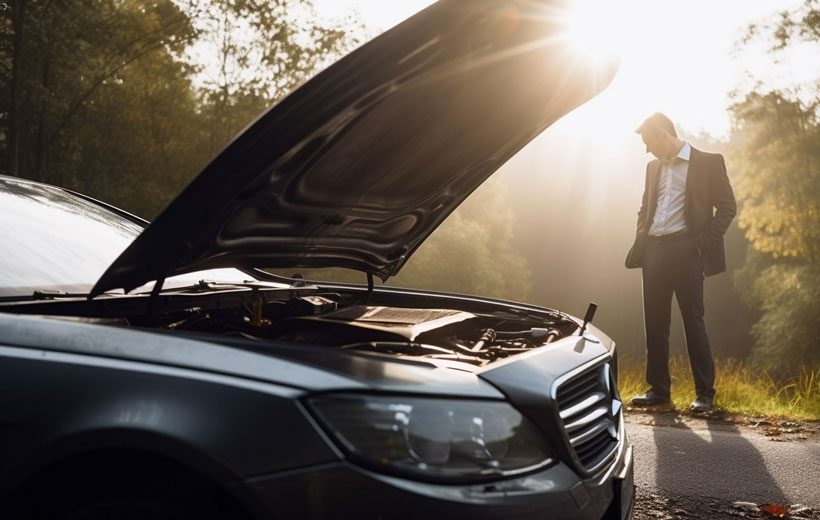
Just because you can’t see a leak doesn’t mean it’s not happening. Leaks can be external and visible or hidden (internal).
A good example of an internal coolant leak is where the intake manifold gasket or cylinder head gasket is leaking.
You may be having a super-small leak that has slowly leaked your coolant over an extended period of time. Or your engine may have burned it all.
So, before you can think of other potential causes, FIRST check your coolant level after your engine has cooled down. Find more info about this explained in the “Failing head gasket” part in the list below.
Here’s our full list of all the potential causes of your car overheating but no leaks:
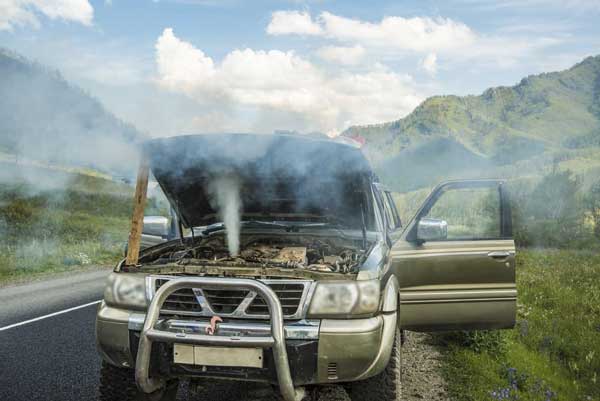
Faulty thermostat
Thermostat should be one of the first things you check into if your car has an overheating problem. The work of a thermostat is to regulate your engine temperature.
When your engine is cold, the thermostat stays closed to ensure coolant circulates around inside your vehicle engine and not through radiator, helping your car warm up quickly.
After your engine hits a certain temperature mark, the thermostat now opens to let coolant flow from engine block to radiator, and thus help cool down your engine and maintain it at its operating temperature range.
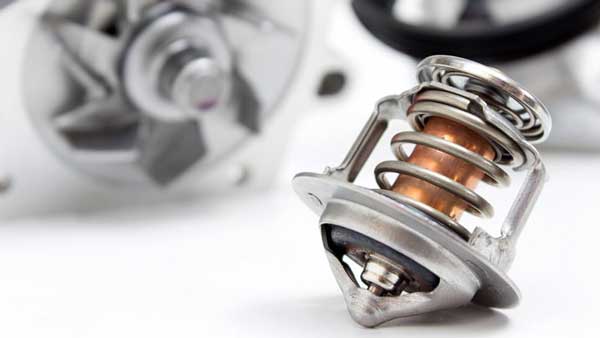
However, if the thermostat is stuck closed or opens partially, the coolant will keep getting hotter inside the engine and won’t circulate through radiator to get cooled down. This will make your car overheat.
Air in the system
If you didn’t bleed your cooling system properly after a coolant change, then it could be the reason your engine is overheating but you can’t see any leak signs.
Bleeding is an essential step in coolant changes as it helps push out any air that may have been trapped in the cooling system or heater core and limits the flow of coolant.
Broken water pump
A faulty water pump can also cause your car to overheat without any leak signs. This part is usually attached to your engine and is run by a serpentine belt.
It helps circulate the coolant around to cool your engine.
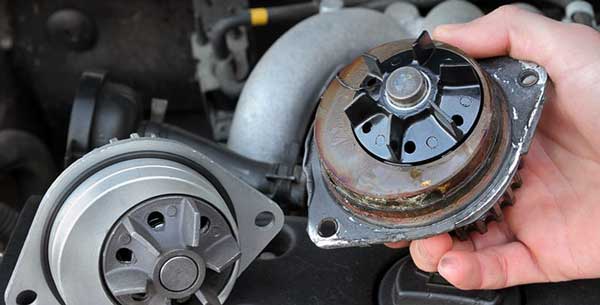
If the pump fails, it means the coolant won’t be moved so it just sits there and starts getting hot—causing your car to overheat.
Plugged hoses
You could also be having plugged coolant hoses that are blocking coolant flow. This is more likely to happen to the radiator coolant hoses.
These are pretty small compared to other lines, making them more vulnerable to clogging.
This limits the amount of coolant that passes through the radiator to replace the hot coolant. If coolant can’t move, it can’t cool your engine, resulting in overheating.
Still at it, if the radiator gets clogged, coolant flow through it will be limited, further increasing the possibility of an overheating problem.
Malfunctioning cooling fans
The fans in your cooling system help pull air over your radiator, and in so doing help cool down your coolant. That said, a faulty fan will result in poor airflow.
There are two types of fans—electric and mechanical.
The mechanical types are usually powered by a serpentine belt which you can easily tell if it’s broken.
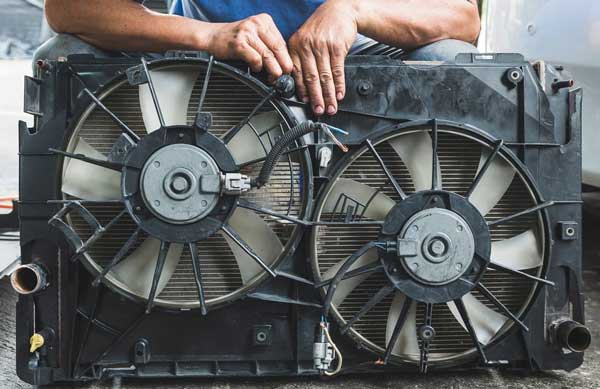
As for the electric fans, they ought to kick on the moment you turn on your car or after the engine starts getting warm.
Keep in mind: Faulty fans are more likely to cause overheating when you’re idling since airflow created around your radiator when driving is sufficient to cool off coolant in your radiator without the intervention of fans.
Failing head gasket
Remember what we said earlier on that a leak could be internal and you not see it? Well, that’s true. And is even more likely to happen if your head gasket is going out.
The head gasket forms a seal between the engine head and block. If it fails, coolant easily sips into the coil and cylinders.
At this point, some tell-tale signs may show up such as your oil turning from black to chocolate milk, colts turning brownish, and white smoke coming out of your tailpipe.
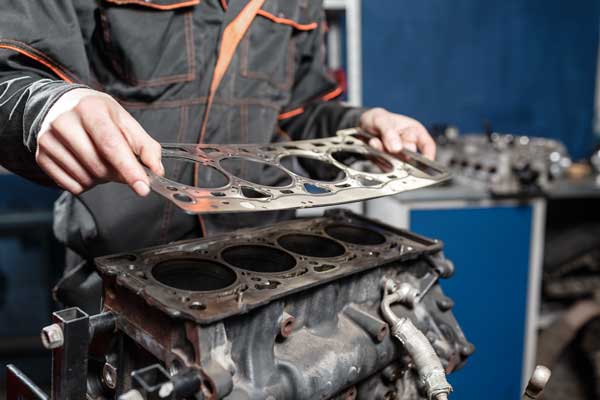
Since your engine will start getting burnt as well as leaking into the oil, the coolant level will go down and your engine will overheat eventually.
NOTE: Gasket head replacement is quite expensive and it may not be worth repairing unless your car is still in nice condition or you love it so much. You may try repairing the head gasket, but this will just be nothing beyond a temporary fix.
How do you fix your car overheating but no leaks?
Your car overheating is a serious issue and we caution you against driving your car in this condition, or else you can cause damage to your engine. Pull over your car to somewhere safe and allow it to cool down.
Once it has cooled down, the first step in fixing the problem is to check the coolant level. if the levels are low, you probably have a super-small leak.
Next, you need to do a coolant pressure test on your car to see if there’s a leak as well as find the source of the leak.
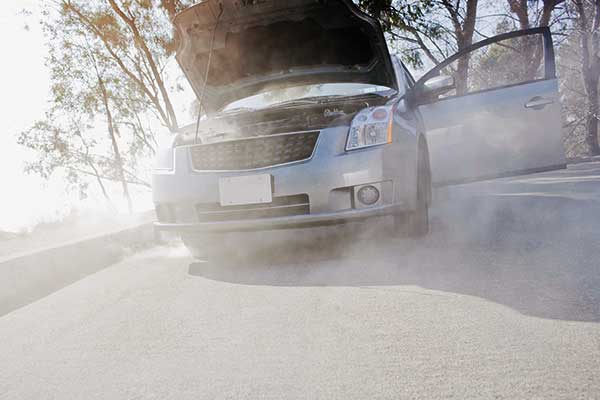
Now move on to the specific parts we mentioned above and inspect them for faults. Start with the thermoset, the cooling fans, the water pump, and the radiator and radiator hoses.
These parts are easy to diagnose on your own and there are countless YouTube videos explaining the basics of inspecting them. Also, check out this overheating engine troubleshooting guide for more info.
Still can’t find anything? Maybe you can also follow an elimination method if you’re in the mood to throw new parts at your car. Start by replacing the thermostat. Then, go to the radiator, and the water pump. See if this helps resolve the overheating problem.
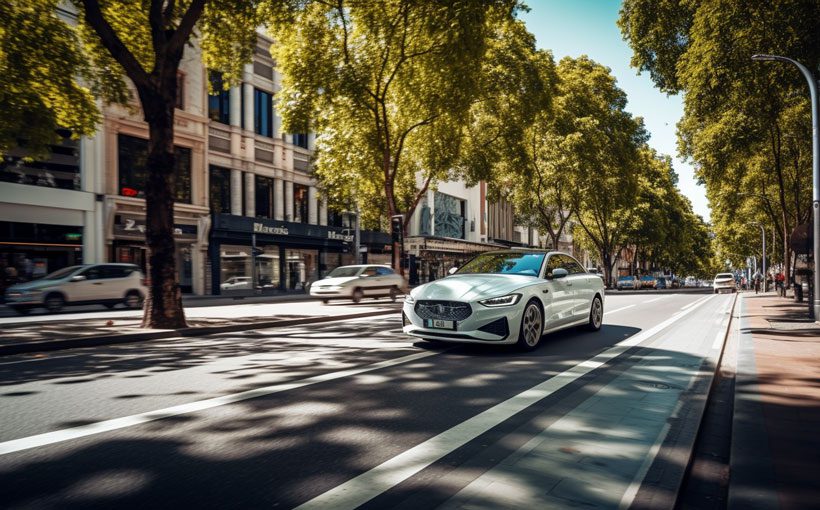
Also, be sure to flush all the old coolant and replace it with a new one. Generally, you should replace your coolant regularly, and when doing coolant system servicing/repairs is the perfect time to flush all that coolant out.
If you can’t see to figure out what’s causing the overheating on your own, then we recommend taking your car to a trusted mechanic to diagnose and fix it for you.
Why is your car losing water and overheating but no leaks?
If your experiencing a situation where your car is losing water and overheating but no leaks are showing, then the first culprit to check is the radiator cap.
If you have a faulty radiator cap with a defective seal, it will lose pressure. That is, water will easily generate high pressure on your defective radiator cap and cause water loss. Replaced the old cap with a new one and see if it helps fix the problem.
The water loss may also be caused by the head gasket leaking the cooling fluid into the cylinder. Testing and checking for actual leaks can help you determine if it’s indeed the head gasket that’s failing.
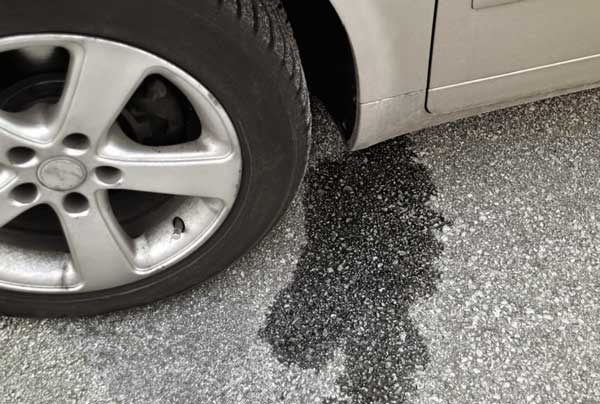
If your tailpipe is removing white smoke or steam during overheating, it could be another tell-tale sign of a blown head gasket. Your thermostat housing gasket being leaky could also cause this problem.
It is also likely that you have a malfunctioning thermostat cussing the overheating and water loss situation. This component may be stuck in a closed position and not functioning as intended.
Overall, this issue is probably radiator cap related and you should always look into it before moving on to other parts.
Why is your car overheating but no leaks with a new thermostat?
In case you just changed your thermostat but your car is still overheating and doesn’t show any signs of a leak, then it means something else is behind the overheating condition.
Firstly, you should rule out the thermostat as the potential cause since you already have a new one in place.
Go ahead and inspect the coolant level. As we said, the leak could be hidden and internal, so it doesn’t always have to be visible to your eyes.
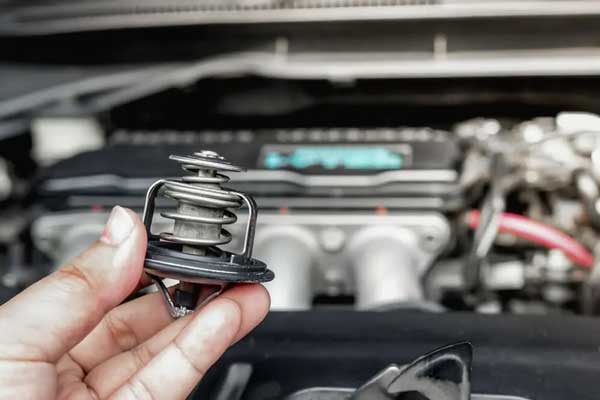
Pressure test your cooling system to see if there are any leaks and where they’re coming from.
Other potential culprits to look into in this case include a broken water pump, a clogged radiator or radiator hoses, non-functioning cooling fans, or even the presence of air in the system.
Get a good mechanic to diagnose your car for the overheating problem and repair or replace any faulty part causing this problem.
Why is my car overheating if it has coolant in it?
Your car overheating but has coolant in it can be caused by a variety of reasons.
But the first thing to check is where you have a faulty thermostat that’s not opening at the correct temperature. Your car may be having full coolant but it won’t help keep your engine cool if it can’t circulate.
Other areas to look into include a broken water pump, bad head gasket, clogged or damaged radiator, clogged radiator hose, bad cooling fan, restriction of airflow, air trapped in the cooling system, and limiting coolant flow.
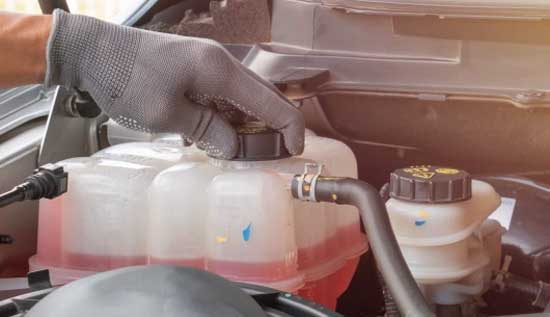
Generally, any blockages in your cooling system limiting proper coolant flow will result in your engine overheating
Also, you may want t check the oil level. You may be surprised the overheating is caused by low oil levels which increase friction between the moving parts of your engine. Friction produces, increasing overheating possibility.
Car overheating but no leaks can be a frustrating and potentially dangerous problem. At MotorAdvices, we have informative articles on a range of automotive issues, including what to do when your car is overheating at idle and when your car is overheating and smoking. Our article on car overheating at idle explains the potential reasons for overheating when your car is not moving and provides solutions to help you keep your engine running cool. Similarly, our article on car overheating and smoking discusses the possible causes of this issue and offers tips on how to fix the problem. Visit MotorAdvices to learn more about how to prevent overheating and keep your car running smoothly, no matter what the cause.FAQs:
If you’re losing coolant but can’t see any leak, it’s likely the leak is internal and the coolant vaporized inside the engine to form a mist. It could also be that the leak is too small for you to see; it could be due to a tiny hole in the radiator, a slightly cracked coolant hose, a water pump issue, etc. Get your car checked by a mechanic to find out the source of the leak.
The best way to find a hidden coolant leak or internal coolant leak is by using a cooling system pressure tester. You hook this tool to the coolant reservoir or radiator cap and then use it to pressurize the cooling system at its usual operating temp. If the system is unable to hold pressure for about 10 minutes, then you have an internal leak.
Final Verdict
Your car can overheat but not show any visible leaks due to a variety of problems. The most common reasons why this happens include a clogged radiator, faulty thermostat, bad water pump, faulty cooling fan, plugged radiator hoses, blown head gasket, or a broken belt. Air trapped in the cooling system may also limit coolant flow and cause overheating with no leaks.
Driving an overheating car can cause destruction to your engine and attract expensive repairs, so you should stop immediately after your temp gauge spikes. Pull over your car and follow the tips we’ve outlined in this guide to diagnose what’s causing the overheating issue. You can then get a good mechanic to fix the faulty parts to make this problem go away.

